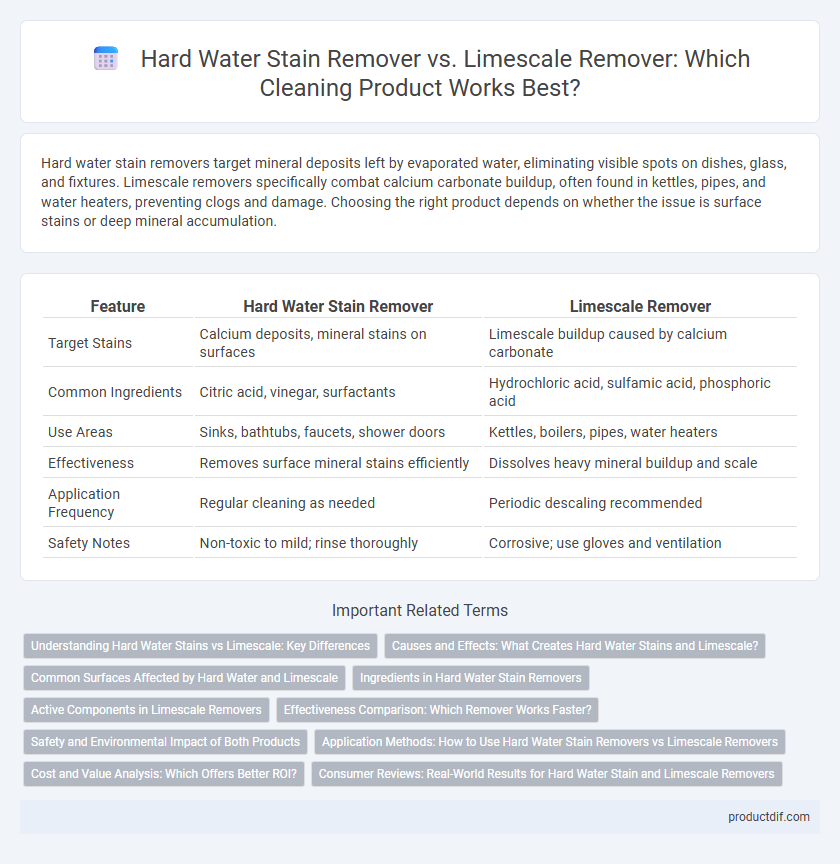Hard water stain removers target mineral deposits left by evaporated water, eliminating visible spots on dishes, glass, and fixtures. Limescale removers specifically combat calcium carbonate buildup, often found in kettles, pipes, and water heaters, preventing clogs and damage. Choosing the right product depends on whether the issue is surface stains or deep mineral accumulation.
Table of Comparison
| Feature | Hard Water Stain Remover | Limescale Remover |
|---|---|---|
| Target Stains | Calcium deposits, mineral stains on surfaces | Limescale buildup caused by calcium carbonate |
| Common Ingredients | Citric acid, vinegar, surfactants | Hydrochloric acid, sulfamic acid, phosphoric acid |
| Use Areas | Sinks, bathtubs, faucets, shower doors | Kettles, boilers, pipes, water heaters |
| Effectiveness | Removes surface mineral stains efficiently | Dissolves heavy mineral buildup and scale |
| Application Frequency | Regular cleaning as needed | Periodic descaling recommended |
| Safety Notes | Non-toxic to mild; rinse thoroughly | Corrosive; use gloves and ventilation |
Understanding Hard Water Stains vs Limescale: Key Differences
Hard water stain removers target mineral deposits like calcium and magnesium that leave cloudy or white spots on surfaces, while limescale removers focus on dissolving hardened calcium carbonate buildup commonly found in kettles, pipes, and appliances. Hard water stains typically form as surface residues, whereas limescale is a thick, crusty layer that adheres firmly to fixtures. Effective cleaning requires using products specifically formulated for either stains or limescale to ensure complete removal and prevent damage.
Causes and Effects: What Creates Hard Water Stains and Limescale?
Hard water stains form when minerals like calcium and magnesium in water accumulate on surfaces, creating cloudy, chalky deposits that dull fixtures and glassware. Limescale results specifically from the buildup of calcium carbonate as hard water evaporates, leading to tough, crusty deposits that clog pipes and reduce appliance efficiency. Both stains and limescale damage plumbing and appliances, causing long-term maintenance issues if not treated with targeted removers.
Common Surfaces Affected by Hard Water and Limescale
Hard water stain removers target mineral deposits like calcium and magnesium that commonly affect bathroom tiles, glass shower doors, and faucets. Limescale removers are specially formulated to dissolve tough limescale buildup on surfaces such as kettles, coffee machines, and plumbing fixtures. Both products effectively restore shine and prevent damage by removing the characteristic white, chalky residues on sinks, bathtubs, and pipes.
Ingredients in Hard Water Stain Removers
Hard water stain removers commonly contain chelating agents such as ethylenediaminetetraacetic acid (EDTA) and surfactants that break down mineral deposits like calcium and magnesium. These products often include mild acids such as citric acid or sulfamic acid to dissolve stubborn water spots without damaging surfaces. In contrast, limescale removers typically rely on stronger acids like hydrochloric acid to tackle thicker mineral buildup in appliances and plumbing fixtures.
Active Components in Limescale Removers
Limescale removers primarily contain active components such as hydrochloric acid, sulfamic acid, and citric acid, which effectively dissolve calcium carbonate deposits by breaking down mineral bonds. These acids are often combined with surfactants to enhance penetration and cleaning efficiency on hard surfaces. Hard water stain removers may contain similar acids but typically include additional chelating agents to target a broader range of mineral and organic residues beyond just limescale.
Effectiveness Comparison: Which Remover Works Faster?
Hard water stain removers typically target mineral deposits like calcium and magnesium with fast-acting acidic agents that dissolve stains within minutes. Limescale removers often contain stronger descaling chemicals designed to break down thicker, aged buildup, which may require longer application times for noticeable results. Overall, hard water stain removers work faster on surface-level deposits, while limescale removers excel in removing stubborn, heavy layers more effectively though sometimes at a slower pace.
Safety and Environmental Impact of Both Products
Hard water stain removers typically contain milder acids, making them safer for regular household use but still requiring gloves and ventilation to prevent skin and respiratory irritation. Limescale removers often feature stronger acidic compounds like hydrochloric or sulfamic acid, posing higher risks of corrosion, chemical burns, and environmental harm if not disposed of properly. Both products demand cautious handling, with eco-friendly formulations emerging to reduce toxic runoff and improve biodegradability, thereby minimizing their adverse environmental impact.
Application Methods: How to Use Hard Water Stain Removers vs Limescale Removers
Hard water stain removers typically require applying the product directly to affected surfaces, allowing it to sit for several minutes before scrubbing and rinsing to dissolve mineral deposits. Limescale removers often involve soaking detachable parts or using specialized applicators to target buildup in pipes, faucets, or appliances, followed by thorough rinsing to prevent damage. Both products demand careful adherence to instructions to optimize effectiveness and protect surfaces from corrosion.
Cost and Value Analysis: Which Offers Better ROI?
Hard water stain removers typically provide a quicker, budget-friendly solution for surface-level cleaning, while limescale removers offer more comprehensive mineral deposit elimination, extending appliance lifespan and reducing long-term maintenance costs. Although limescale removers may have a higher upfront price, their effectiveness in preventing damage to plumbing and appliances delivers a superior return on investment over time. Evaluating product labels for active ingredients such as phosphoric acid or sulfamic acid helps determine which remover maximizes cleaning efficiency and value for household or commercial use.
Consumer Reviews: Real-World Results for Hard Water Stain and Limescale Removers
Consumers report that hard water stain removers effectively eliminate mineral deposits caused by calcium and magnesium, restoring surfaces like glass and tiles to a spotless finish. Limescale removers excel in dissolving tough calcium carbonate build-up found in kettles, pipes, and bathroom fixtures, often receiving praise for quick action and ease of use. Real-world reviews highlight product formulations with citric acid or vinegar compounds as top performers for tackling both hard water stains and limescale build-up efficiently.
Hard water stain remover vs limescale remover Infographic

 productdif.com
productdif.com